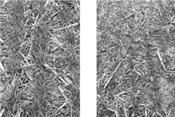Kentucky Producers: Time To Assess Wheat Fields For Yield Potential
PRINCETON, KY.
Kentucky wheat producers need to assess their fields to decide whether to keep or terminate the crop following several months of extreme weather conditions, said Carrie Knott, extension grain crops specialist in the University of Kentucky College of Agriculture, Food and Environment.
Kentucky agricultural producers have dealt with wet, cool and cloudy conditions throughout 2018 and this winter. Knott said early-planted wheat appears to have faired better this winter than wheat planted on time or late. Wheat planted during the recommended planting window and later may show delayed development due to the weather. Producers may also have fields with considerable yellowing and reduced stands due to excessive precipitation, while other fields may be suffering due to repeated freezing and thawing cycles that provided the potential for plant roots to heave out of the ground.
“In general, wheat plants are extremely resilient and can recover from considerable stressors endured during the winter,” Knott said. “But given the extreme conditions this fall and winter, coupled with the fact that many fields planted in late October and November only recently emerged from the soil and have not had the opportunity to produce tillers, there may be some wheat fields that may be more profitable if planted with full-season soybeans.”
Stand counts will help producers determine their crops’ yield potential and next steps. Producers should complete stand counts when the crop reaches the green-up growth stage (Feekes 3). Producers should count from a 3-foot row section at several locations within a field, only counting the plants with at least three leaves. They can then convert to tillers per square foot by multiplying their average stand counts by four and then dividing it by their row width. With this information, they can access a yield potential chart located at
https://wheatscience.ca.uky.edu/files/february_2019_-_wheat_newsletter_0.pdf or in Section 3 of the UK Cooperative Extension Service publication ID-125: A Comprehensive Guide to Wheat Management in Kentucky to make decisions. ∆

Wheat stands planted in early October, left, have much more growth than wheat planted the third week
of October, right, in Princeton.
Photos by Carrie Knott, UK extension grain crops specialist